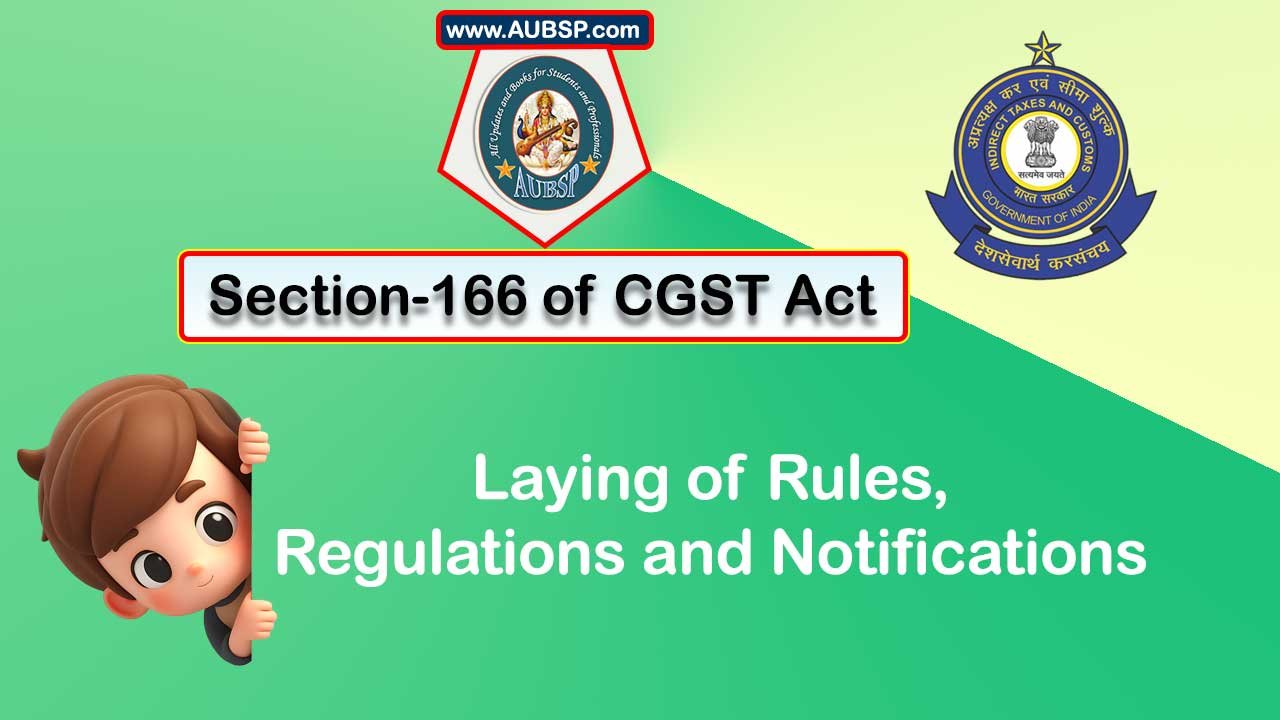Amended and updated notes on section 166 of CGST Act, 2017. Detail discussion on provisions and rules related to laying of rules, regulations and notifications.
Chapter XXI (Sections 143–174) of the Central Goods and Services Tax Act, 2017 deals with the provisions related to miscellaneous. Section 166 of CGST 2017 provides for laying of rules, regulations and notifications.
Recently, we have discussed in detail section 165 (Power to make regulations) of CGST Act 2017. Today, we learn the provisions of section 166 of Central GST Act 2017.
Section 166 of the Central Goods and Services Tax Act, 2017 has been notified by the Ministry of Finance vide Notification No. 1/2017-Central Tax, G.S.R. 605(E), dated 19.06.2017. This notification was come into force from 22nd June, 2017 i.e. the commencement date of section 166 is 22-6-2017.
| Name of Act | The Central Goods and Services Tax Act 2017 |
|---|---|
| Enacted by | Parliament of India |
| Administered by | Central Board of Indirect Taxes & Customs |
| Governing body | GST Council |
| Number of Chapters | 21 |
| Number of Sections | 174 |
| You are reading: | |
| Chapter No. | XXI |
| Chapter Name | Miscellaneous |
| Section No. | 166 |
| Section Name | Laying of rules, regulations and notifications |
| Updated 2025 Edition | GST Law Book PDF |
Section 166 of Central GST – Laying of rules, regulations and notifications1
Section 166 of CGST Act 2017 shall come into force on 22.06.2017 vide Notification No. 1/2017-Central Tax, G.S.R. 605(E), dated 19.06.2017.
Every rule made by the Government, every regulation made by the Board and every notification issued by the Government under this Act, shall be laid, as soon as may be after it is made or issued, before each House of Parliament, while it is in session, for a total period of thirty days which may be comprised in one session or in two or more successive sessions, and if, before the expiry of the session immediately following the session or the successive sessions aforesaid, both Houses agree in making any modification in the rule or regulation or in the notification, as the case may be, or both Houses agree that the rule or regulation or the notification should not be made, the rule or regulation or notification, as the case may be, shall thereafter have effect only in such modified form or be of no effect, as the case may be; so, however, that any such modification or annulment shall be without prejudice to the validity of anything previously done under that rule or regulation or notification, as the case may be.
- Section 166 of CGST Act 2017 shall come into force on 22.06.2017 vide Notification No. 1/2017-Central Tax, G.S.R. 605(E), dated 19.06.2017. ↩︎
Notes on Section 166 of CGST Act
Explanation of CGST Section 166: Laying of Rules, Regulations, and Notifications
Section 166 of the Central Goods and Services Tax (CGST) Act, 2017 ensures parliamentary oversight over the rules, regulations, and notifications issued under the Act. It establishes a system of checks and balances by requiring that every rule, regulation, and notification made under the Act be laid before Parliament.
Key Provisions of Section 166
- Mandatory Presentation to Parliament
- Any rule made by the Government, regulation made by the Board, or notification issued under the CGST Act must be presented before both Houses of Parliament (Lok Sabha and Rajya Sabha).
- Timeframe for Parliamentary Review
- The rule, regulation, or notification must be laid as soon as possible after its issuance.
- It must remain before Parliament for a total of 30 days, which can be:
- In one session, or
- Spread over two or more successive sessions.
- Parliament’s Power to Modify or Reject
- If both Houses agree before the end of the session(s) that:
- Any modification is needed → The rule, regulation, or notification takes effect in the modified form.
- It should be revoked → It ceases to have any effect.
- If both Houses agree before the end of the session(s) that:
- Effect of Modification or Rejection
- Any modification or annulment does not affect the validity of actions already taken under that rule, regulation, or notification before the modification or annulment.
Purpose of Section 166
- Ensures accountability of the executive branch.
- Gives Parliament a chance to review and control delegated legislation.
- Provides a mechanism to modify or nullify rules, regulations, or notifications if deemed necessary.
This provision safeguards against arbitrary rule-making and ensures that the Government’s decisions align with legislative intent.

